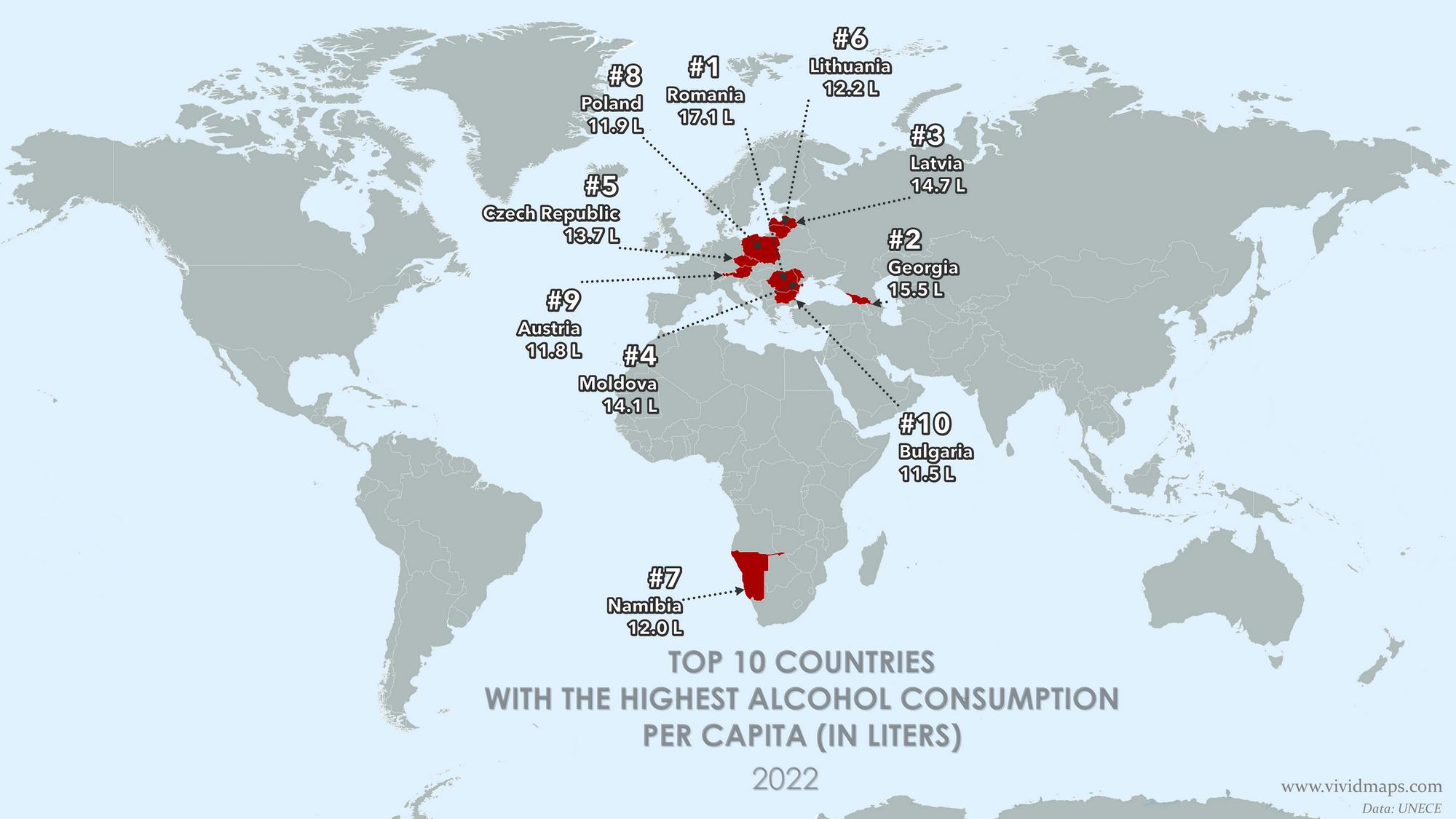Top Countries by Alcohol Consumption Per Capita Map


Alex Cartwright
Senior Cartographer & GIS Specialist
Alex Cartwright is a renowned cartographer and geographic information systems specialist with over 15 years of experience in spatial analysis and data...
Geographic Analysis
What This Map Shows
The "Top 10 Countries by Alcohol Consumption Per Capita (2022)" map provides a clear visualization of the highest levels of alcohol consumption across various nations. Specifically, it ranks countries based on the litres of pure ethanol consumed per person aged 15 and older. This data, sourced from the UNECE SDG indicator 3.5.2, paints a fascinating picture of global drinking habits, highlighting cultural, social, and economic influences on alcohol consumption.
Deep Dive into Alcohol Consumption Patterns
Alcohol consumption is a significant aspect of many cultures around the world, often reflecting social norms, traditions, and even economic conditions. The countries at the top of this list, such as Romania and Georgia, demonstrate varying historical and cultural relationships with alcohol. For instance, Romania, leading the chart with a staggering 17.1 litres of pure ethanol consumed per capita, has a rich tradition of wine production that dates back centuries. Wine is not only a staple at Romanian tables but is also a vital part of their cultural identity.
Georgia follows closely with 15.5 litres per capita. Known for its ancient winemaking techniques, Georgia's landscape is dotted with vineyards that have contributed to its high consumption rates. Interestingly, the country has one of the oldest winemaking traditions in the world, which plays a crucial role in social gatherings and religious ceremonies. Georgia's unique grape varieties and methods create a strong cultural connection to alcohol that is reflected in their consumption statistics.
Latvia and Moldova round out the top four, with 14.7 and 14.1 litres consumed per capita, respectively. Latvia has a vibrant pub culture, and its local beer is a point of pride. Meanwhile, Moldova, often overshadowed in discussions about wine, has a burgeoning wine industry that has recently gained international acclaim. The traditional Moldovan home is often accompanied by wine, showcasing its importance in daily life and celebrations.
What’s fascinating is how the consumption of alcohol can influence health and societal trends. High levels of alcohol consumption are often associated with various health risks, including liver disease, addiction, and increased mortality rates. This brings a pressing public health concern alongside cultural practices. Many countries are now grappling with how to maintain their cultural ties to alcohol while addressing the health implications that arise from excessive consumption.
Regional Analysis
When analyzing the map regionally, Eastern Europe stands out as a significant area of high alcohol consumption. Countries like Romania, Latvia, and Moldova share not only geographical proximity but also similar cultural attitudes towards alcohol. In contrast, Western European nations tend to have lower per capita consumption rates, often due to stricter drinking regulations and a growing emphasis on health and wellness among the population.
Interestingly, while some countries have a long-standing tradition of wine and beer consumption, others are witnessing a shift. For example, in Latvia, beer is the most popular alcoholic beverage, and it’s deeply embedded in social life, from casual meet-ups to major festivals. On the other hand, Moldova's wine industry is experiencing a renaissance, with efforts to modernize vineyards and attract international tourists, further influencing consumption patterns.
What’s also worth noting is the impact of globalization and changing lifestyles. In many regions, particularly urban centers, younger populations are shifting their drinking habits, often opting for craft beers or artisanal spirits. This shift might impact future consumption trends, making it essential to keep an eye on how cultural practices evolve over time.
Significance and Impact
Understanding alcohol consumption patterns is not just a matter of curiosity; it has profound implications for public health, economic development, and cultural identity. Countries with high consumption rates often face challenges related to health care costs and social issues stemming from alcohol misuse. For example, Romania's high consumption is matched by public health initiatives aimed at reducing alcohol-related harm, showcasing the duality of tradition and modern health considerations.
Moreover, as global awareness of health issues grows, there's a noticeable trend towards moderation and responsible drinking. Countries are beginning to implement more robust regulations regarding alcohol sales and advertising, reflecting a shift in societal attitudes towards alcohol. This could lead to a decrease in consumption rates, particularly among younger generations. The future landscape of alcohol consumption is likely to be shaped by these ongoing cultural, economic, and health discussions.
In conclusion, the map of top countries by alcohol consumption per capita offers more than just numbers; it tells a story of cultural heritage, health implications, and evolving societal norms. As we continue to explore these patterns, it's crucial to consider how they reflect broader trends in our global community.
Visualization Details
- Published
- October 7, 2025
- Views
- 34
Comments
Loading comments...